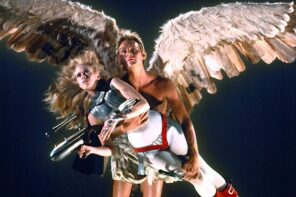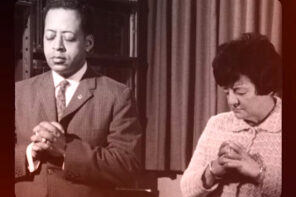For months, the buzz about Paul Thomas Anderson’s new movie was that it was “the Scientology film,” with the main character, Lancaster Dodd (Philip Seymour Hoffman), a fictional stand-in for Scientology’s founder L. Ron Hubbard. Online comments sections were rife with speculation that the Church of Scientology would stop at nothing to keep Anderson from revealing “the truth” about Hubbard. But Anderson has insisted that the movie is not about Scientology. “It’s not the L. Ron story,” he explained.
Either way, I think The Master qualifies Anderson for an honorary degree in the study of new religious movements—a field little known outside the academy, but with huge significance for real-world religious and civil life.
Instead of setting out to debunk Scientology, The Master is driven by Anderson’s genuine curiosity about religious charisma. The writer-director got the idea for the film after reading that postwar America was a particularly fertile environment for new religious movements. This idea brought together a number of other themes and ideas that had been rattling around in his head for some time, catalyzing them into a coherent story.
Scientology-watchers will spot many connections between the film’s charismatic leader and Hubbard. Anderson researched the early history of Scientology by reading through The Abberree, a newsletter published from 1954-1965 by two of Hubbard’s early followers—he also studied the personalities of such charismatic figures as Aimee Semple McPherson, Werner Erhard, and Jim Jones to create Lancaster Dodd.
It was Hoffman who suggested the story was not actually about the nominal Master, but his disciple, Freddie Quell (Joaquin Phoenix). By shifting the emphasis toward the disciple, The Master makes for a more interesting study in charismatic leaders.
Anthropologist Charles Lindholm has written that, “Charisma is, above all, a relationship, a mutual mingling of the inner selves of leader and follower.” The chemistry between Hoffman and Phoenix suggests this dynamic. It is not simply that Dodd is a megalomaniac who desires mastery over others. Rather, his followers, particularly the troubled Freddie, desire a master—they actively mold Dodd into this role.
Skeptics know that Dodd cannot really “fix” Freddie by uncovering traumatic events that happened to him in previous lives. Nor can these unusual therapeutic techniques cure leukemia or avert the threat of nuclear war as Dodd claims. But if the Master cannot do these things, then who can? What hope does the world have?
Before and after his travels with The Master, Freddie is shown drunk on a beach, sleeping with an arm draped over a lewd sculpture of naked woman that his fellow sailors have constructed from sand. This image seems an apt metaphor for charisma—Freddie’s beloved, the object of his desire, has no independent existence but is actually the collective creation of many hands.
Scholars or “Cult-Apologists”?
The other reason that Anderson deserves recognition as an honorary scholar of new religious movements is that his curiosity about new religions has brought him into conflict with a culture that still approaches the religious other through an un-nuanced “us vs. them” mentality. Most religion scholars who deal heavily with new religious movements have been branded as “cult apologists” at some point in their careers. At stake in this accusation is an assumption that “whoever is not for us is against us,” and that anyone who is not actively attempting to debunk and discredit minority religions has decided to defend them unconditionally.
I have written for here and elsewhere that for some commentators, ridiculing Scientology seems to have become a kind of hobby. There are, of course, plenty of reasons not to like the Church of Scientology. Not the least of these are the serious allegations that have been leveled against the Church by former members, especially the children of Scientologists who were raised in Scientology schools or pressured to serve in the Church’s elite order, Sea Org.
But as disturbing as these stories are, I am more interested in the motivations of groups like Anonymous, who organized angry protests in front of Scientology buildings, and journalists like Tony Ortega, who in two years produced 465 articles attacking the Church of Scientology.
In a world threatened by the possibility of nuclear conflict in the Middle East, global warming, and growing economic injustice, why direct so much energy toward a religion that is culturally and politically irrelevant outside of Hollywood? What is the sense of satisfaction some people find in crusading against Scientology? Popular animosity toward Scientology is interesting because it seems to point toward much larger patterns in how Americans respond to minority religions.
As if to prove my point, the comments sections below these articles were instantly filled with outraged posts from the opponents of Scientology. Failing to understand that I was writing about them, they misinterpreted my comments as a defense of Scientology. The posters explained that Scientology should not be studied as a religion because it is in fact “a cult.” Tony Ortega suggested that academics are inherently incapable of understanding the threat that Scientologists present. One individual demanded to know how much the Church of Scientology had paid me to write such things.
Anderson’s exploration of new religious movements has run up against a similar hermeneutic of “us vs. them.” One article crowed that The Master would be “the biggest fictional middle finger ever flown” at Scientology. When film critic Rex Reed slammed the film as “pretentious sermon,” a commenter suggested that Reed was likely a Scientologist himself. In response to journalists who seemed eager to celebrate The Master as an attack on Scientology, Anderson found himself forced to take the opposite position. He explained that he has become “much more defensive and protective of [Scientology] than I would have thought.” I know how he feels. Like new religious movement scholars, Anderson appears to be struggling to define his work as neither an attack nor a defense of the religious other, but rather an exploration of it.
Like Anderson’s treatment of the oil industry in There Will Be Blood or the pornography industry in Boogie Nights, The Master uses Scientology as a backdrop through which to examine the drama of human existence. This approach to Scientology gives me hope that we can one day have a public discussion about figures like L. Ron Hubbard without accepting the hagiographical accounts of Scientologists or reducing these figures to villainous madmen.
Once we bypass this “either/or” mentality, it is possible to explore much more interesting questions about the history of ideas and the human search for meaning.




